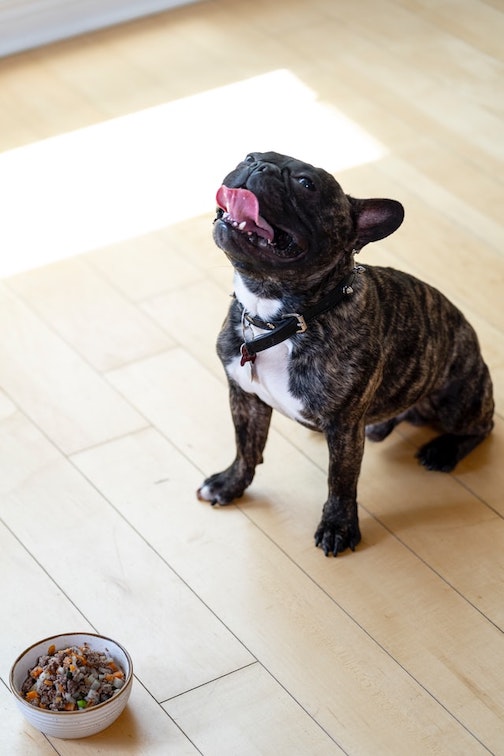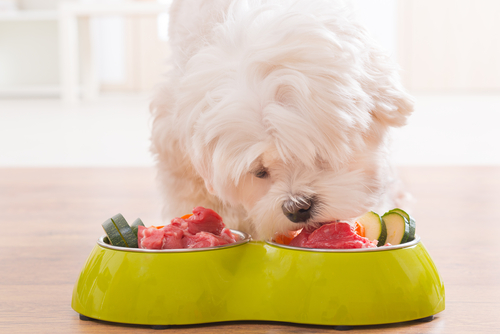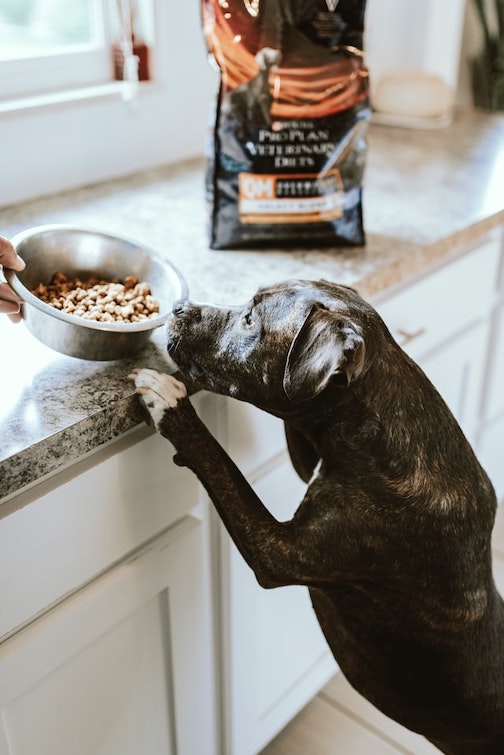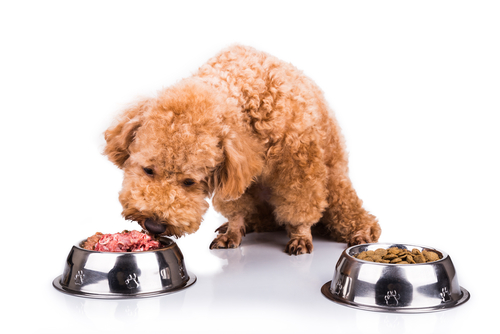Raw Food Diet for Dogs: Healthy or Harmful?
Posted: 01/09/2023 | BY: Erin Cain | Categories: Dog , Pet care
It’s no secret or surprise that many aspects of dog stewardship involve serious and often passionate debates about the best way to care for our canine friends. One of the most contested aspects of canine care is the appropriate diet for our domesticated dogs. This point of debate is understandable as the proper diet can ensure your dog has a healthier, happier, and lengthier life. But what about a raw food diet for dogs?
Over the last decade, the raw food diet for dogs has steadily transformed from a supposed fad to a legitimate and popular feeding method. There is so much conflicting and controversial information available about raw food diets that it’s easy to become confused about what this diet can and can’t do for your pup. Here’s an overview of the raw food diet for dogs and whether it is healthy or harmful to dogs.

What is a canine raw food diet?
A canine raw food diet is based primarily on uncooked organ and muscle meat, crushed or whole bones, raw eggs, vegetables, and some fruit and dairy. Based on the natural diet of wolves, dogs’ ancestors, the raw diet was first established by Dr. Ian Billinghurst, a veterinarian and pet nutritionist. He believes that dogs and cats’ diets evolved through millennia of genetic adaptation. Due to the way our pets’ bodies are designed to eat natural foods, that is what pet parents should feed them.
Billinghurst named the raw diet Biologically Appropriate Raw Food (BARF), and sled dogs and racing Greyhounds were the groups first fed this diet. The BARF diet became more popular amongst dog parents as more recalls began to happen with processed, commercialized dog foods over the last decade. There are two types of raw food diets, homemade and commercially prepared frozen or fresh meats in patty form.

How can a raw food diet benefit your dog?
Billinghurst and other advocates for the canine raw food diet argue that the diet provides these benefits to dogs:
- More energy
- Shinier, softer, healthier coat and skin
- Smaller, solid, less smelly stool
- Cleaner, healthier teeth
- Adaptable diet to account for specific nutrition requirements
- No processing or preservatives added
- Improved digestion
- Reduced allergies
- Improved weight management
- Reduced health risks, including cancer
Perhaps the most powerful argument in favor of a raw food diet is the dangers posed by traditionally processed dog kibble. There have been plenty of horror stories involved with kibble recalls, and not without merit: kibble is processed, cooked food with artificial preservatives and dyes to promote the shelf life of a bag of dog food. Hence, kibble is cheaper than fresh or raw foods, and therefore, understandably more attractive to budget-strapped or conscious pup parents.
Raw food diets have become more common due to the fears associated with what is cooked into kibble. For example, artificial preservatives like ethoxyquin, butylated hydroxyanisole, butylated hydroxytoluene, propylene glycol, corn syrup, and food dyes lead to higher incidences of cancer in canines. Natural dog food is healthier, but that doesn’t mean that a raw food diet is without its potential problems.

What harm can a canine raw food diet cause?
Canine raw food diets are not without risks, which any pup parent considering switching their dog to a raw diet should know. The highest risk is associated with safety. Raw meats can contain human and canine pathogens, such as E. coli, salmonella, and campylobacter.
The University at Liverpool’s Institute of Infection and Global Health researched and concluded that dogs who eat a raw diet shed more pathogens in their feces than dogs fed a cooked diet. The findings make sense as, in general, there are 23 million coliform bacteria per gram of dog feces. E. coli is the pathogen most global health organizations are concerned about due to antibiotic resistance and Enterococci bacteria because of its association with urinary tract infections in humans. Although the risks of pathogen transfer from dogs to humans are highest for elderly, children, and immune-compromised individuals, that is important information for a pup parent to have when deciding to switch their dog to a raw food diet.

Ultimately, the best way to prevent the spread of these pathogens is to follow appropriate hygiene recommendations, just as you would do when handling raw meat that you are preparing for your family’s dinner: when you are done preparing raw chicken, you wash your hands, utensils, cutting boards, countertops, and bowls. You may also want to avoid letting your dog kiss you on the face or mouth or wash your face immediately after he does.
Another risk for dogs lies in the bones included in a raw food diet. Bones that are not ground up thoroughly or not removed from food can cause physical damage to a dog. Large sections of bones can splinter when a dog chews them, causing intestinal obstructions, perforations, choking, or broken or chipped teeth.

What do veterinarians say about the raw food diet?
Many veterinarians and veterinary organizations are skeptical of canine raw food diets. Some primary concerns are feeding your dog a diet that fails to provide a balanced nutrition and that processed kibble is a safer choice, despite its proven dangers, because the FDA regulates all pet food products. Some vets argue that dogs’ digestive systems have evolved differently from the wolf over the last few centuries so that dogs are better able to digest and adapt to starches in their food.
In contrast, wolves have better abilities to process pathogens in raw meat. Others argue that the supposed benefits of a raw food diet are anecdotal, and there is not enough evidence to prove that those benefits are real.
On the other hand, some veterinarians advocate for a raw food diet because they believe it is a more biologically appropriate diet that does not contain processed ingredients or artificial preservatives. In some cases, veterinarians may approve raw diets due to a dog’s allergies or specific nutritional requirements.
Final Thoughts
It can be very confusing knowing the optimal nutrition for your dog as there are so many differing opinions out there. It’s always a good idea to begin by speaking with your veterinarian to see what he or she thinks. Having said that, not all vets are necessarily knowledgeable when it comes to a holistic approach to feeding and treating animals. If your vet is a traditional vet and not a holistic vet, they may simply not have all of the information at their disposal. In this case, do you own research. Look online for raw food feeding forums. Talk to other pet parents to get an idea of whether or not feeding your dog raw foods might be an optimal choice.
Help your dog stay healthy by choosing the right diet.
Talk with your veterinarian before changing your dog’s diet, whether you are switching from kibble to raw or one brand of kibble to another. Your vet can advise you what’s best for your pup’s needs and evaluate your dog based on whichever diet you feed him.
Keep your dog healthy and happy with the proper diet and a pet insurance policy. Get a free personalized quote through Pet Insurance Review today.
References:
- Billinghurst, I. (2021). BARF. Retrieved from https://drianbillinghurst.com/barf/
- Janisse, K. (2021). Homemade Raw Dog Food: A Complete and Balanced Raw Diet for Your Dog. Retrieved from https://blog.homesalive.ca/dog-blog/homemade-raw-dog-food
- R., B. (2021). Best Raw Dog Food Brands. Retrieved from https://www.thatmutt.com/best-raw-dog-food-brands/
- U.S. Food & Drug Administration. (2021). Recalls & Withdrawals. Retrieved from https://www.fda.gov/animal-veterinary/safety-health/recalls-withdrawals
- Dr. Ron’s Animal Hospital & Emergency. (2021). The Adverse Health Impact of Chemicals in Pet Food. Retrieved from https://www.drronsanimalhospitalsimivalley.com/blog/the-adverse-health-impact-of-chemicals-in-pet-food/
- University at Liverpool Institute of Infection and Global Health. (n.d.). Do raw meat diets pose health risk for our pets and us? Retrieved from https://www.liverpool.ac.uk/infection-and-global-health/research/pet-health/raw-pet-food/
- Earth Rated. (2021). Why You Should Pick Up Your Dog’s Poop: Infographic. Retrieved from https://earthrated.com/en/blog/why-you-should-pick-up-your-dogs-poop-infographic/
- Pask, L. Scott, L. (2012). The Raw Debate. Retrieved from https://moderndogmagazine.com/articles/raw-debate/756
- Cassella, C. (2021). Raw Dog Food Could Be Fueling The Spread Of Antibiotic-Resistant Superbugs. Retrieved from (https://www.sciencealert.com/raw-dog-food-could-be-fuelling-the-spread-of-antibiotic-resistant-superbugs
Disclaimer
The information contained on this blog is intended for informational and educational purposes only and should not be construed as medical advice. It is not a substitute for professional veterinary care. Always consult with your veterinarian before making any changes to your pet's health care or treatment plan.
The authors of this blog are not veterinarians and do not claim to be experts in pet health. The information provided here is based on our own experiences and research, as well as information from reputable sources. However, we cannot guarantee the accuracy or completeness of this information.
We encourage you to do your own research and consult with your veterinarian before making any decisions about your pet's health.
Previous post
Dog Training Tips For New Pup ParentsNext post
Should You Give Your Dog Coconut Oil?Compare top pet insurance providers & plans.
Enter your dog’s age in years and months to calculate their age equivalent to human years.
Calculate your dog’s ageEnter your cat’s age in years and months to calculate their age equivalent to human years.
Calculate your cat’s age